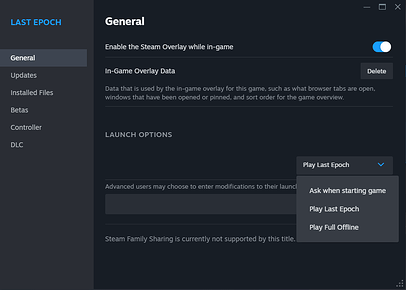Last Epoch is an ARPG that strikes a careful middle ground between Diablo 4 and Path of Exile 2, with some excellent new ideas of its own.
Our Verdict: 8/10
Last Epoch is an ARPG that puts mechanics first, and does so with a resounding sense of class identity. Its player-friendly design ensures you have all the tools you need for the job, and rivals such as Diablo 4 and Path of Exile 2 would do well to pay attention to some of its smartest innovations.
After five years in early access,
Last Epoch is finally here. Arriving squarely between the launches of Blizzard behemoth Diablo 4 and the upcoming Path of Exile 2 from Grinding Gear Games, this ARPG has long been heralded as the ideal middle ground between D4’s beginner-friendly systems and Path of Exile’s unrelenting depth and complexity. Built by Eleventh Hour Games, originally formed as a passion project by developers who met through Reddit, Last Epoch certainly bears the mark of that scrappy upstart origin. Yet it’s also clear that this is a game built by people who love the genre and have spent a lot of time playing it, and the result is one of the most delightfully player-friendly and welcoming RPGs I’ve ever played – one that pushes the genre forward in some ways its bigger-name rivals would do well to take note of.
The loot-driven world of action
RPG games is so resolutely ruled by the clashing titans of Diablo and Path of Exile that I would be remiss not to draw comparisons. Yet I’ll try to refrain from belaboring the point; suffice to say that, in almost every respect possible,
Last Epoch feels squarely positioned between the simpler, tighter focus of Blizzard’s Diablo 4 and the vast, winding systems of Grinding Gear Games’ Path of Exile – right down to its asking price of $35/£30, halfway between the full-priced D4 and the free-to-play PoE. In true Goldilocks fashion, however, it turns out that the resulting concoction tastes just right to me, even if the bowl it’s served in is a little rough around the edges.
The loot-driven world of action
RPG games is so resolutely ruled by the clashing titans of Diablo and Path of Exile that I would be remiss not to draw comparisons. Yet I’ll try to refrain from belaboring the point; suffice to say that, in almost every respect possible,
Last Epoch feels squarely positioned between the simpler, tighter focus of Blizzard’s Diablo 4 and the vast, winding systems of Grinding Gear Games’ Path of Exile – right down to its asking price of $35/£30, halfway between the full-priced D4 and the free-to-play PoE. In true Goldilocks fashion, however, it turns out that the resulting concoction tastes just right to me, even if the bowl it’s served in is a little rough around the edges.
Having been on both sides of that experience myself, the enthusiasm works a treat – despite it throwing quite a few options at you from the get-go, I quickly find myself drawn into crafting my first build, and it’s refreshingly easy to come up with something that feels ‘mine’ on the fly without having to turn to guides or study charts. I am an Acolyte – and, more specifically, a Lich; what starts with some light experimentation quickly takes form, and almost before I know it my direction is set.
I’m a veritable avatar of putrefaction, dripping self-damaging poison that constantly battles my own bulked-up health regeneration as it infects and drains the armor of those around me. I’m capable of unleashing torrents of bone shards ripped from my own flesh that tear through entire hordes, shredding their armor and inflicting heavy bleeding. In a pinch, I can detonate my very body, damaging those around me as I reform a short distance away. Bringing it all together is my signature ability, with which I transform into a scythe-wielding reaper, dashing through foes to inflict heavy poison buildup in a form I can maintain for as long as my life-leeching attacks keep an ever-draining secondary health bar topped up.
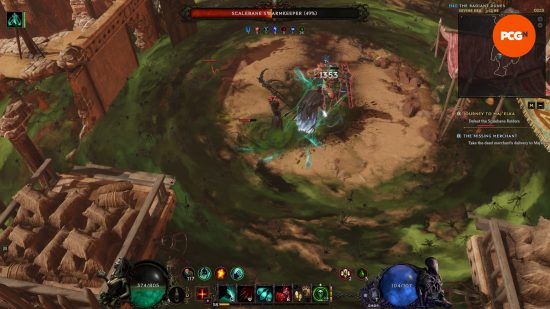
The sense of class identity is magnificent, and yet it’s just one of many ways I could kit out my Lich. While I didn’t get to spend time with all of them, it’s a feeling that echoes across all five Last Epoch classes and their respective masteries. Each class – Acolyte, Mage, Primalist, Rogue, and Sentinel – branches out early on into one of three masteries. The bulky Primalist, for example, can become a shapeshifting Druid, wield the elements as a Shaman, or summon an army of companions as a Beastmaster. Sadly, there’s just one character model for each of the five classes, with no alternate gender or look options, though you’ll quickly be covered with the gear you pick up anyway, so it’s perhaps not the end of the world (more on that later).
Your choice of mastery is made early on and, unlike most decisions in Last Epoch, can’t be undone without starting a fresh character, which feels like a slight oversight. You get a set of 12 active skills (ten for Rogues, 13 for Mages) to choose from with your base class, along with a passive skill tree. Picking your mastery grants you access to another set of four or five new skills and a second passive tree, but you can also complement your build with skills and passives from the first half of the other two masteries – you’re just locked out of the really good stuff.
From the skills at your disposal, you’ll pick five to specialize in as you rise through the levels. You can swap these out without too much fuss if you decide you’re sick of a particular one, though. Your chosen skills level along with you as you play, each offering their own unique upgrade tree that lets you optimize and alter them. Here’s where Last Epoch really begins to come into its own, granting you everything from simple stat bonuses and ‘kiss and curse’ style stronger buffs with an associated downside, to complete alterations in functionality that, in some cases, reimagine the skill as something almost entirely different. It’s not unlike Path of Exile’s skill gem system, but it feels vastly more directed and manageable from the off.
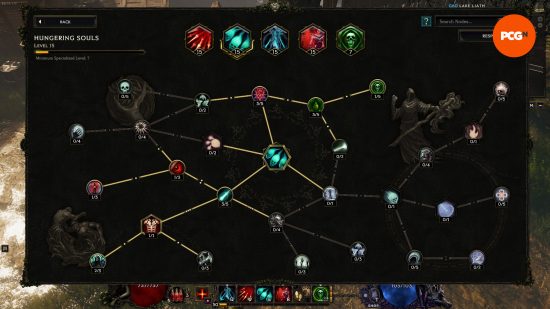
Enhancing all of this is your gear, and Last Epoch has a
lot of it. Fortunately, you get a larger inventory than I’m typically used to in ARPGs and, crucially, you aren’t expected to pick it all up. I know this might feel counterintuitive at first, but I quickly realized that holding onto items to sell to vendors gave me almost no gold, and that’s because Last Epoch places a much greater emphasis on taking the best gear you find and further crafting and honing it yourself. Don’t panic, though; as someone who’s never truly wrapped my head around Path of Exile crafting even after a full decade of playing, Last Epoch’s setup is one of the most simple and satisfying systems I’ve seen in an ARPG.
Last Epoch crafting is all about juicing up the bonuses on your equipment by stuffing them with shards. You’ll snag plenty of these as you adventure, but you can get specific ones by smashing up gear you don’t need to get the matching shards. You’re limited only by the shards you have to hand, and the item’s ‘forging potential’ – each time you jam a stat-boosting shard in, you’ll spend a random amount of potential, and once it’s all gone that item can no longer be improved any further.
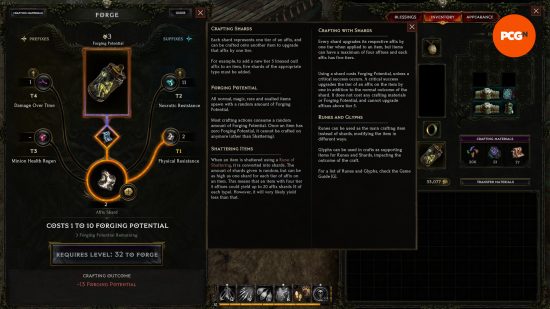
Helpfully, you can pull up the crafting forge on the fly wherever you are, so if you find an item with great stats that you won’t use you can smash it right there and then. All your crafting materials are stored in an unlimited box, and you can dump any you pick up straight in there with one button click. There’s even a handy sort button that instantly resolves the Tetris puzzle of inventory management to maximize your available space, making it easier than ever to grab everything you want.
The secret sauce that makes all of this work is the Last Epoch loot filter. I’ve long steered clear of making my own loot filters in ARPGs that offer them, sheepishly downloading the latest Path of Exile offering with each new league. Eleventh Hour has made them so wonderfully simple and on the fly, however, that they feel less like a chore and more like magic at my fingertips. Just tap Shift + F to pull the menu up, click a couple of buttons, and you’re done. If you want to create an intricate, in-depth filter – or download a pre-made one with a quick copy and paste – you absolutely can, but I found myself just adapting one as I went.
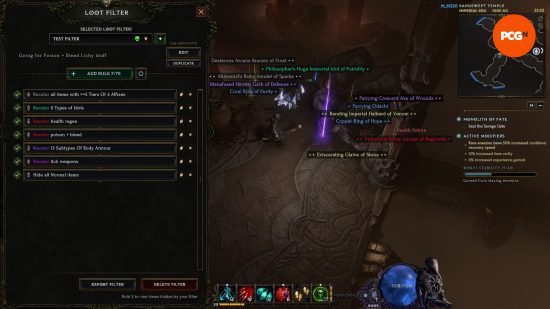
In the market for a new hat that fits? Set all of your class helms to show up as pink – or dig deeper into the menu and pick the individual ones you’re after (conveniently, the loot filter interface even shows all the base stats on each item type right there). Desperately seeking more fire resistance? Tick ‘emphasize’ on items that drop with it and they’ll show up with big, bold labels. Never want to see another basic, white-rarity item again? Simply hide them all and you’re free forever – though you can always hold X while playing to temporarily disable the filter and see what you might have missed.
I’m very cognizant of the fact I’ve waffled about gear and skills and stats for an age, although fundamentally they are what Last Epoch is all about; this is, after all, a game about making builds that feel exciting, powerful, and yours, and it’s really good at that. But what of the campaign? The central narrative hook is that thanks to the Last Epoch, that eponymous artifact, you have the ability to travel through time rifts between five different eras – the prehistoric Ancient era, the Divine era of gods, the Imperial era, the futuristic, crumbling Ruined era, and the very End of Time itself (I told you we’d get back to it).
The result is something that can often feel a little all over the place, especially in the early stages, where you’re constantly tossed between timelines, each one pouring lore over your head in a frankly unmanageable deluge of fantasy names and factions. Fortunately, in a sort of reverse Final Fantasy manner, Last Epoch’s story actually settles down in its latter half and becomes much more focused and streamlined, leaving me to wonder whether this was a result of the game’s development throughout early access. Either way, if you’re expecting a cinematic experience on the scale of Diablo 4’s campaign, you’ll probably be somewhat underwhelmed, although there are some strong boss fights towards its climax.
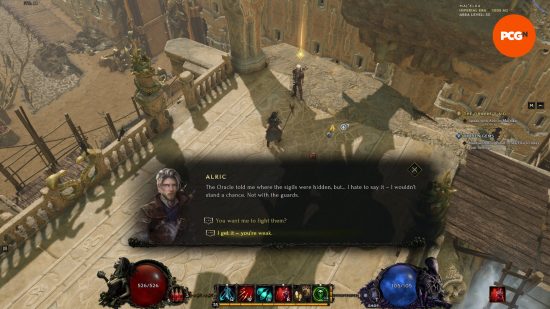
The other notable thing to mention is the writing, which seems unsure whether it wants to be taken seriously or treat everything as a joke. You’re presented with constant dialogue choices, but almost all of them have a sarcastic or ‘witty’ tone to them, and the result is a story that feels like its characters don’t really care what actually happens and are just along for the ride. I didn’t hate it – at times it even gave me a chuckle – but for all the world-sundering calamity there’s a resounding insincerity to the whole thing that might leave some feeling cold.
The setting does provide a pretty fantastic diversity of environments, and sees you going up against everything from dinosaurs to space gods, although I was pleased that I still somehow managed to end up in a sewer surrounded by rats at one point. Some things never change.
What Last Epoch lacks in thematic consistency, then, it gains in variety – and, for a game you might want to grind through for dozens or even hundreds of hours, that’s perhaps welcome. Visually, it’s certainly far from a triple-A level of polish, but I do rather like looking at it.
The combat feels good – perhaps not quite as tight as its closest rivals, and the absence of a dedicated dodge is notable alongside its presence in both Diablo 4 and Path of Exile 2, but there’s enough dedicated mobility skills at your disposal to let that slide, and I’ll give a particular nod to the clarity of incoming danger signs – both the bigger enemy attack animations and the ‘dodge this’ markers on the ground are consistently easy to spot in the heat of battle, avoiding the frustration of dying to something you didn’t see coming. Enemy modifier descriptions, too, are clear and concise, so it’s quick to see what you’re up against.
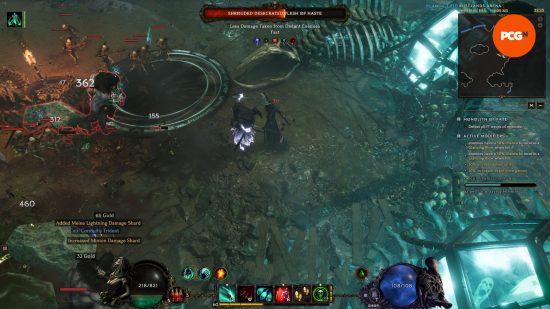
The Last Epoch campaign certainly gets quite challenging as you progress, so you’ll need to keep your gear up to scratch – by around act eight, your elemental resistances really need to be up to scratch, or you’ll melt in a moment. Die and you’re told which damage type killed you, though sadly only for the final hit. Fortunately, the aforementioned crafting and loot filter makes solving gaps in your defenses relatively easy – a fact compounded by the ability to leap into the endgame before you’ve actually finished the main story. I took just the briefest sojourn there when I ran into a wall at the end of the eighth act, and in almost no time I’d made some big upgrades and was right back on course.
That endgame is where Eleventh Hour expects you to spend most of your time, and it’s broken up into three key parts. The fundamental bread and butter is the Monolith of Fate, where you fight your way through a web of levels (called Echoes) while completing objectives and eventually taking on story quests to further amplify the difficulty and, with it, the potential rewards. Each Echo you take on has specific challenge modifiers and, in many cases, these will last for the next several Echoes you take on, so you’ll have to plot your course through the web wisely. Finish an entire timeline within the Monolith and you’ll also net a permanent blessing for your character. It’s nothing revolutionary, bearing somewhat of a resemblance to PoE’s map system, but this might be a case of ‘if it ain’t broke, don’t fix it.’
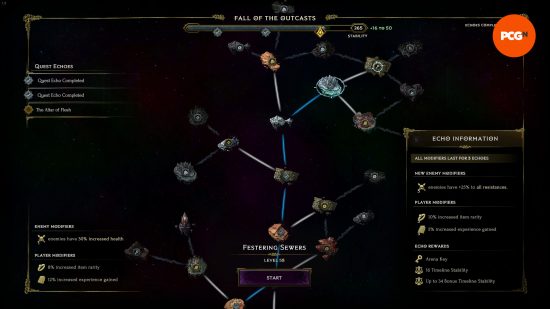
The second component of the Last Epoch endgame is the Arena – this is its simplest challenge, and boils down to a never-ending wave survival mode. It is where you’ll find leaderboards, however, so if you’re looking to prove that you’re the best in the world then here’s your chance. You can filter by class, mode, and player count, too, ensuring that it’s always a fair comparison at the top.
The final piece of the puzzle are the Last Epoch dungeons. These are Eleventh Hour’s real ace up the sleeve, each coming with unique mechanics and a specific, valuable reward for completing them. The first, Lightless Arbor, requires you to maintain a flame as you fight through; reach the end and you can pump ever more gold into a vault to gamble for increasingly numerous rewards. In the second, Soulfire Bastion, you’ll have to toggle an elemental shield back and forth as you go to avoid otherwise fatal incoming damage; manage to make it through and you can roll the dice on new gear types of your choice.
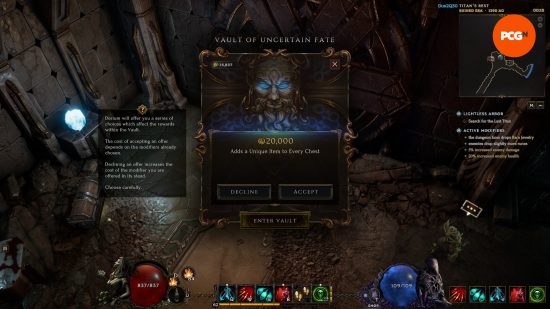
The last and most interesting is the Temporal Sanctum. Beating this requires you to jump between multiple timelines, both to progress past obstacles and to deal with the enemies you’ll face within. At its end lies the Eternity Cache, used to make the most powerful items. Find a unique item (one that has its own exclusive bonus) with ‘legendary potential’ and you can smash another high-stat item into it using the Eternity Cache to make something truly monstrous. These dungeons are perhaps my favorite feature in all of Last Epoch, and the only downside is that there’s just three of them at launch.
But why play fair? It turns out that Last Epoch has another ace up its sleeve –
item factions. Towards the end of the story, you’ll have the option to join either the Merchant’s Guild, which lets you trade with other players, or the Circle of Fortune, which restricts you from trading but dramatically boosts your own drop rates. It’s one of the smartest ways I’ve ever seen to handle the balance between players who love to swap gear with others and those who are resolutely solo enthusiasts, and having long felt at a distinct disadvantage as someone who always avoids trading I finally feel truly seen.
Along with the standard softcore/hardcore split, Last Epoch also offers both ‘solo account found’ (where you can only use items dropped in your own game) and ‘solo character found’ (a stricter version that prevents you from taking items from your own alts). Even better, play regularly with a friend and you’ll earn a special currency that you can use to send them any item you find as a gift, even if it dropped while you weren’t actively playing alongside them. There’s also the option to play entirely offline, which is a welcome addition, although your offline characters are kept separate from your online roster.
I mentioned up-top that Last Epoch is perhaps the most player-friendly ARPG I’ve played, and I want to re-emphasize that in closing. Every decision along the way feels as though it’s designed to help you have a good time. Remember all the debate about Diablo 4’s five (now six) stash tabs? Last Epoch gives you 200, all purchasable with in-game gold, and you can rename them, recolor them, and even sort them into separate folders. Beyond vastly eclipsing Blizzard’s offering, that’s also a lot more storage than you’d get were you to spend $35 buying Path of Exile stash tabs, for what it’s worth.
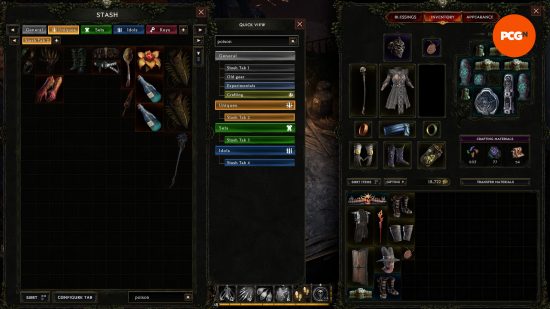
That convenience runs through the whole game, too. Looking for skills to complement your ice build? Simply type ‘ice’ into the search bar to highlight all your passive points that mention it. Not sure what tier your item stats are? Hold the alt key and you’ll be told both that and the possible stat roll range for each. In fact, you’ll even get a detailed description of what every single stat on the gear does and how it interacts with other systems where needed. Wondering whether ‘bonus elemental damage’ affects your lightning build? Just hold alt to check – or hover over your skills to see the full list of tags that will benefit their output.
At every step of the way, Last Epoch wants to make sure you aren’t left in the dark about anything, and that serves to encourage experimentation. Having been through the campaign and into the endgame with my Lich, I can’t wait to do the same on more characters – and not just the different classes, but their masteries too. That means I effectively have 15 completely different styles at my disposal, and I’m already cooking up at least two completely new ways I would consider building a Lich the next time I make one. The potential is exciting.
It’s not without issue. The endgame is probably plentiful for launch, but Eleventh Hour will have to deliver new systems and features with its seasonal ‘cycles’ to keep things feeling fresh. While I really enjoyed some of its tougher fights, I’ve yet to encounter anything on the level of Path of Exile’s pinnacle bosses. Load times also tend to linger more than I’d like, despite playing on one of the best
SSDs for gaming. It’s not a complete mood killer, but when you’re blasting through Echoes it can be a little disjointing.

While I wasn’t able to look at them pre-launch, it’s important to note that there will also be cosmetic microtransactions in Last Epoch. Eleventh Hour is adamant that they’ll only ever be cosmetic, with no convenience or power available to buy, but it does mean that there’s currently no way to change the look of your character’s outfit without spending real money. It’s a little disappointing after Diablo 4’s rather robust in-game transmog system, which was enough to satisfy my fashion needs without reaching for my wallet.
For all their respective communities’ posturing, Diablo 4 and Path of Exile have never truly been rivals – they offer two rather diverse takes on the ARPG format. By positioning itself between them, Last Epoch serves to act as a direct competitor to both, and yet it somehow manages to offer a compelling alternative to the two market leaders simultaneously. If you’re someone who wants a bit more long-term depth and variety than Diablo 4 currently offers, or are seeking an alternative to Path of Exile that you can learn in hours and weeks, rather than months and years, Last Epoch might well be the game you’ve been looking for.
Whether that changes when the
Path of Exile 2 release date arrives, or the
Diablo 4 Vessel of Hatred release date for that matter, remains to be seen. The actual, boring answer is that all three of these games can probably coexist, and that Last Epoch is simply a welcome addition to the team. But, as it stands, Eleventh Hour Games has sent the ball firmly into Blizzard and Grinding Gear Games’ court, and both could pick up some worthwhile tips from all the places Last Epoch succeeds.







![Glory to Codexia! [2012] Codex 2012](/forums/smiles/campaign_tags/campaign_slushfund2012.png)




